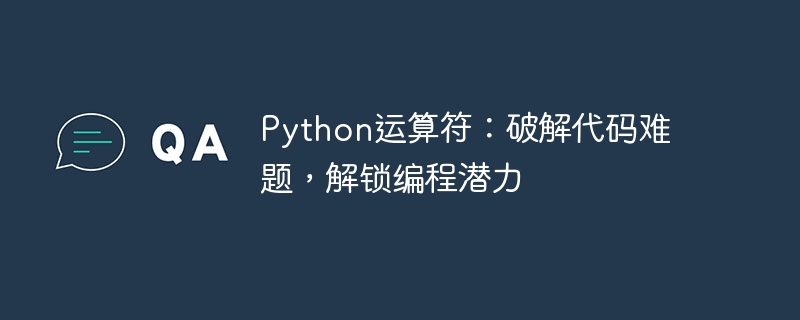Home >Backend Development >Python Tutorial >Python Operators: Cracking Code Puzzles and Unlocking Programming Potential
Python Operators: Cracking Code Puzzles and Unlocking Programming Potential
- WBOYforward
- 2024-03-11 09:10:27921browse

Operators are powerful tools in python that allow manipulation of data and control of program flow. Mastering operators is the foundation of becoming a skilled Pythonprogrammer. This article will explore Python operators in depth, from basic arithmetic operators to advanced logical operators, to help you solve coding problems and unleash your programming potential.
Arithmetic operators
Arithmetic operators are used to perform calculations on numbers. The most common arithmetic operators include:
-
:Addition - -
:Subtraction - *
:multiplication - /
: Division (floating point number) - //
: Division (integer) - **
:power
Example:
# 加法 sum = 10 + 20 # 减法 difference = 20 - 10 # 乘法 product = 10 * 20 # 浮点数除法 quotient = 10 / 20 # 整数除法 quotient = 10 // 20 # 幂 result = 2 ** 3
Relational operators
Relational operators are used to compare two values. They return True or False, depending on the comparison result. Commonly used relational operators include:
- ==
:Equal - !=
:Not equal - :less than
- >
: greater than - : less than or equal to
- >=
: greater than or equal to
Example:
# 相等 is_equal = 10 == 20 # 不相等 is_not_equal = 10 != 20 # 小于 is_less_than = 10 < 20 # 大于 is_greater_than = 10 > 20 # 小于等于 is_less_than_or_equal = 10 <= 20 # 大于等于 is_greater_than_or_equal = 10 >= 20
Logical Operators
Logical operators are used to combine Boolean values and control program flow. The most common logical operators include:
- and
:Logical and - or
:logical or - not
:logical not
Example:
# 逻辑与 is_both_true = (10 == 10) and (20 > 10) # 逻辑或 is_either_true = (10 == 20) or (20 > 10) # 逻辑非 is_false = not (10 > 20)
Conditional operator
Conditional operators are used to return different values based on conditional expressions. It has the following format:
condition ? value_if_true : value_if_false
Example:
# 根据分数判断等级 grade = "A" if score >= 90 else "B"
Member operator The
Membership operator is used to check whether an element belongs to aset. The most common membership operators are in and not in.
Example:
# 检查列表中是否存在元素 is_in_list = "apple" in ["apple", "banana", "orange"] # 检查元素不在列表中 is_not_in_list = "grape" not in ["apple", "banana", "orange"]
Advanced operators
Python also provides some advanced operators, including:
- is
: The identification of the comparison object - is not
: Identification negation of the comparison object - lambda
: Create an anonymous function - yield
: Pause the execution of the function and generate the value
The above is the detailed content of Python Operators: Cracking Code Puzzles and Unlocking Programming Potential. For more information, please follow other related articles on the PHP Chinese website!

